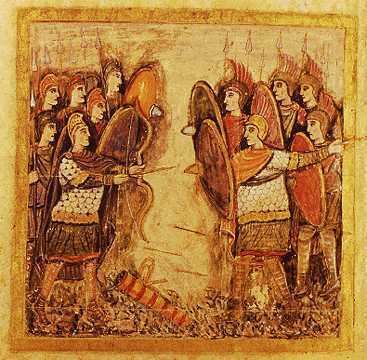 | ||
The Trojan Battle Order or Trojan Catalogue is an epic catalogue in the second book of the Iliad listing the allied contingents that fought for Troy in the Trojan War. The catalogue is noted for its deficit of detail compared to the immediately preceding Catalogue of Ships, which lists the Greek contingents, and for the fact that only a few of the many Trojans mentioned in the Iliad appear there.
Contents
Historicity question
Structurally the Trojan Battle Order is evidently inserted to balance the preceding Catalogue of Ships. It is, however, much shorter. Denys Page summarizes the prevailing explanation that "the Catalogues are substantially Mycenaean compositions rather expanded than altered by the Ionians" (Page 1963, pp. 153–154). Noting that the Greek catalogue occupies 265 lines but the Trojan catalogue only 61, Page wonders why the Ionian authors know so little about their native land and concludes they are not describing it but are reforming poetry inherited in oral form from Mycenaean times (Page 1963, pp. 137–139).
Some examples of Mycenaean knowledge are (Page 1963, pp. 141–143):
There is also some internal evidence that the Trojan catalogue was not part of the Iliad but was a distinct composition pre-dating the Trojan War and incorporated later into the Iliad (Page 1963, p. 140):
Page cites several more subtle instances of the disconnectedness of the Trojan catalog from the Iliad; neither is it connected to the catalog of Greek forces. Another like it appears in the Cypria (Burgess 2004, p. 138).
The catalogue in detail
The catalogue lists sixteen contingents from twelve different ethnonyms under 26 leaders (Luce 1975). They lived in 33 places identified by toponyms.
Analyses
The list includes the Trojans themselves, led by Hector, and various allies. As observed by G. S. Kirk, it follows a geographical pattern comparable to that of the Greek catalogue, dealing first with Troy, then with the Troad, then radiating outwards on four successive routes, the most distant peoples on each route being described as "from far away".(Kirk 1985, p. 250). The allied contingents are said to have spoken multiple languages, requiring orders to be translated by their individual commanders. Nothing is said of the Trojan language; the Carians are specifically said to be barbarian-speaking, possibly because their language was distinct from the contemporaneous lingua franca of western Anatolia.
The classical Greek historian Demetrius of Scepsis, native of Scepsis in the hills above Troy, wrote a vast study of the "Trojan Battle Order" under that title (Greek Trōikos diakosmos). The work is lost; brief extracts from it are quoted by Athenaeus and Pausanias, while Strabo cites it frequently in his own discussion of the geography of northwestern Anatolia.
